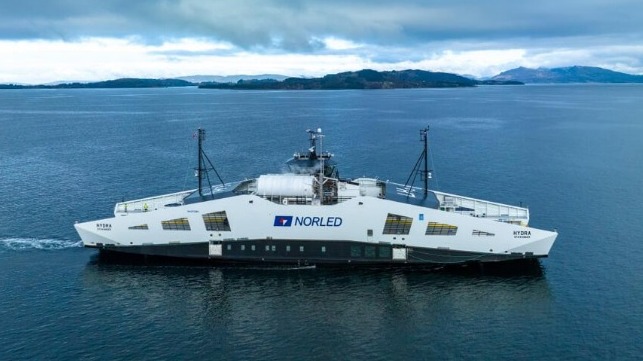Video: Norway’s Hydrogen-Powered Ferry Begins Service

Norway marked another first in the development of hydrogen-fueled shipping. After years of development, the MF Hydra, the first commercial ferry operating on liquid hydrogen entered regular service. The vessel is a pioneer in the technology and a demonstration of the potential of hydrogen, but it is also helping to define the rules for hydrogen-fueled commercial shipping.
While there are a few examples of hydrogen-fueled shipping already in service, such as a workboat launched last year by CMB.TECH of Belgium, much still needs to be developed and learned about the use of the fuel. The Norwegians are highlighting that other than Norled, the shipping company operating the ferry, and the MF Hydra, the space industry in its rocket propulsion is one of the few current large users of hydrogen.
The partners in this new project highlight that when the work on the MF Hydra started, both the technology and regulations from the classification societies and the Norwegian Maritime Authority were inadequate. Their project among others has helped to advance these fronts with the first regulations in place for the handling and use of hydrogen-fueled ships.
“It has been an incredibly exciting, educational, and challenging project. We must commend our competent cooperation partners on this journey, and not least the NPRA (Norwegian Public Roads Administration). They made liquid hydrogen a requirement in their tender specification, forcing the development of new technology. Together we have made history,” said Erlend Hovland, Chief Technology Officer of Norled.
The new ferry builds on Norway’s heritage in innovation. They highlight the MF Glutra launched in 2000 that became the first car ferry to run on liquefied natural gas. Eleven years ago, the NPRA issued a tender that resulted in the construction of MF Ampere, an electric ferry with a propeller drive. They also called for the innovation of the hydrogen-fueled ferry while Norled is also proceeding with larger, electric-battery-driven ferries.
The project worked closed both with the Norwegian regulators and DNV to get them to the point of putting the MF Hydra into service. In addition to the challenges associated with hydrogen, the ferry was adapted with a universal design with wide and threshold-free access roads without the use of a lift. There are also large public areas for passengers with windows that will provide a lot of natural light in the lounge, and a viewing area for the hydrogen installation.
MF Hydra is 270 feet long with a 56-foot beam. The ferry is connecting the national road between Hjelmeland - Skipavik - Nesvik in Rogaland, Norway. It has a capacity of 299 passengers as well as 80 cars and 10 cargo trailers. The vessel was designed to use three tons of liquid hydrogen every three weeks. The ferry has an 80 cbm hydrogen storage tanks and is expected to reduce its annual carbon emissions by up to 95 percent. It has a service speed of 9 knots.
The vessel was built by Norway’s Westcon Shipyard. Linde Engineering in Germany supplied the hydrogen systems while Danish Ballard developed the fuel cells that produce electricity from hydrogen. Westcon in Ølensvåg was responsible for equipping and completing the vessel together with system integrator SEAM from Karmøy. Seam has also supplied the automation scope for the hydrogen system. Corvus Energy supplied the batteries.
Since the beginning of 2023, MF Hydra and Norled have been carrying out tests at the quay in Hjelmeland. In recent weeks, they have been running sea trials and received the final approvals from the Norwegian Maritime Authority (NMA).

that matters most
Get the latest maritime news delivered to your inbox daily.
“MF Hydra confirms Norway's world-leading position in the development of new green maritime solutions,” said Ada Jakobsen, CEO of Maritime CleanTech. “By putting the world's first hydrogen ferry into operation on a Norwegian ferry connection, we are once again showing how purchasing power and good public-private partnerships can be used to develop new and groundbreaking technology.”
The vessel is now entering regularly scheduled operations. In addition to providing an important demonstration for hydrogen-fueled operations, they expect it will contribute to the knowledge helping to advance future developments.
